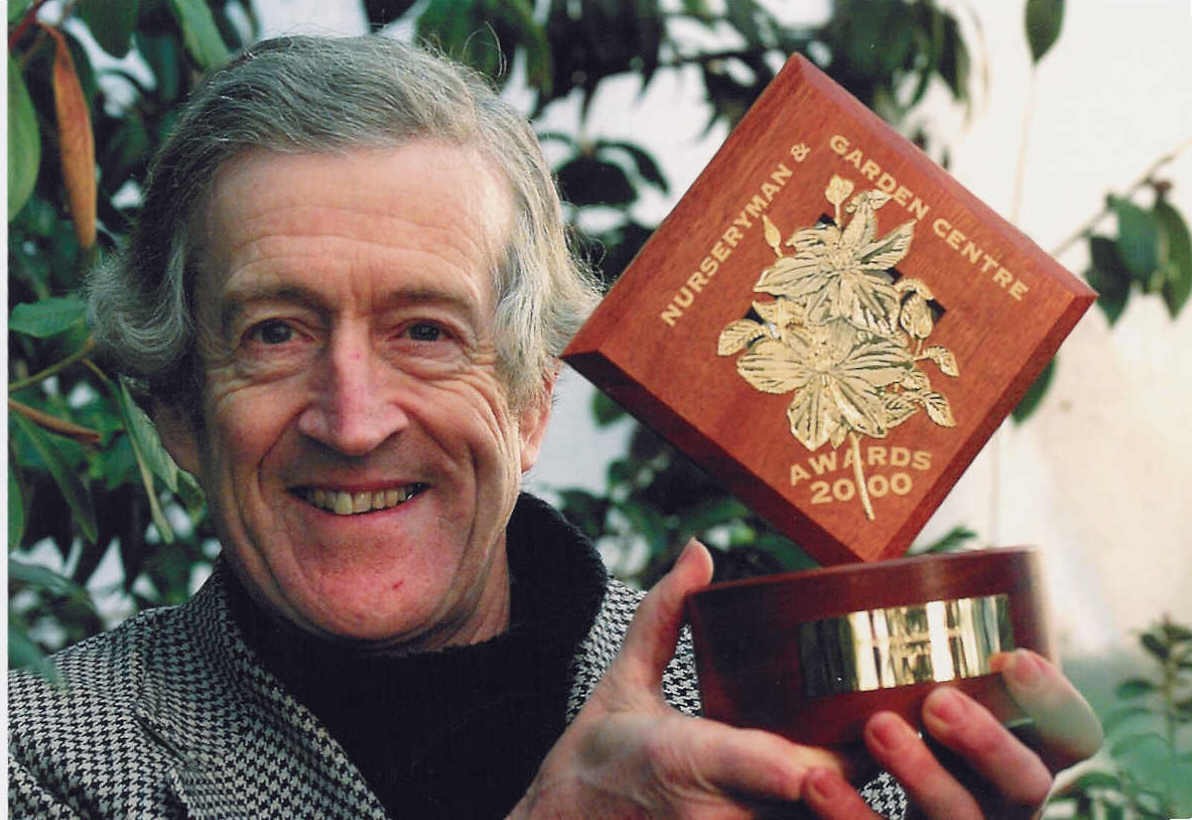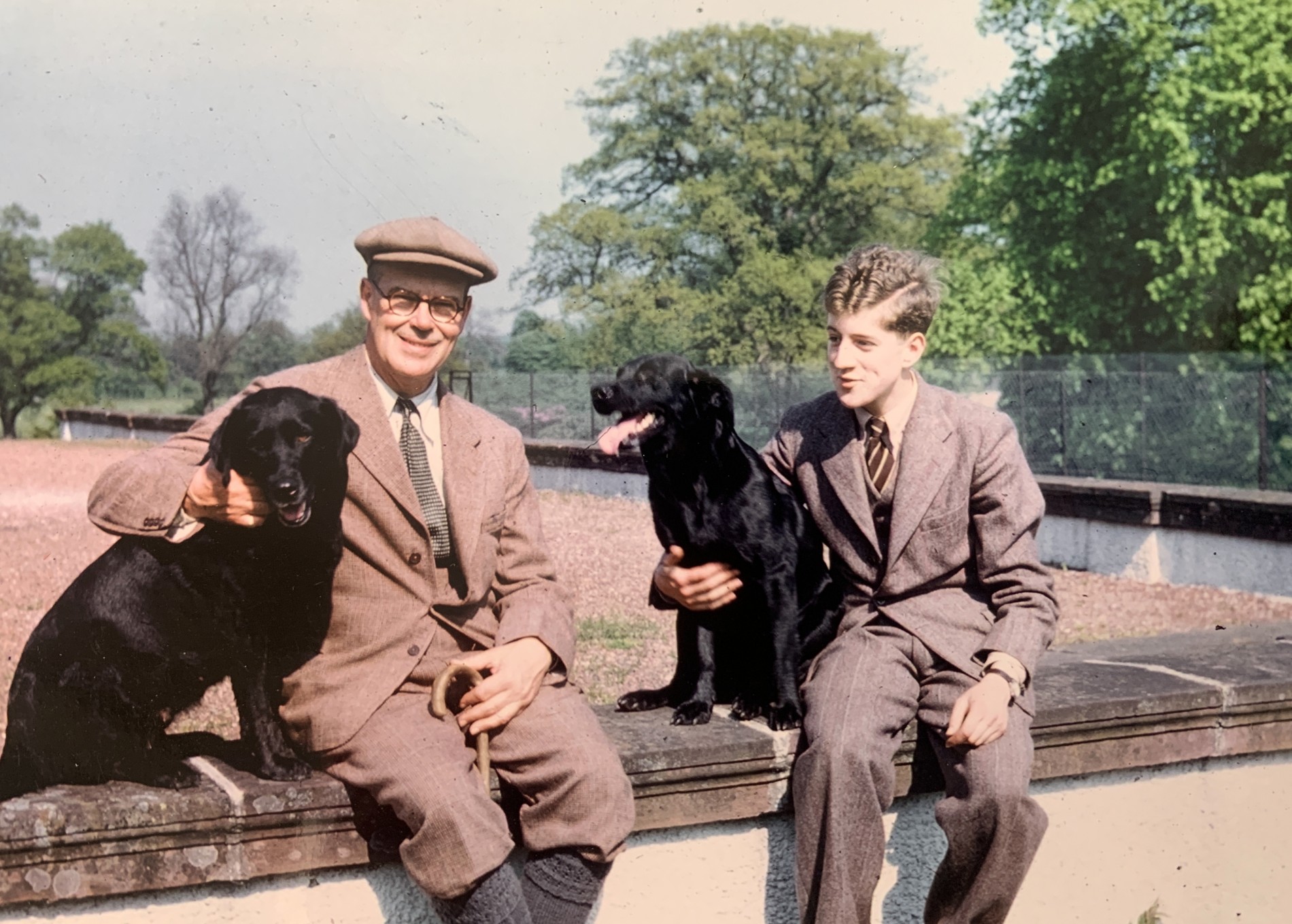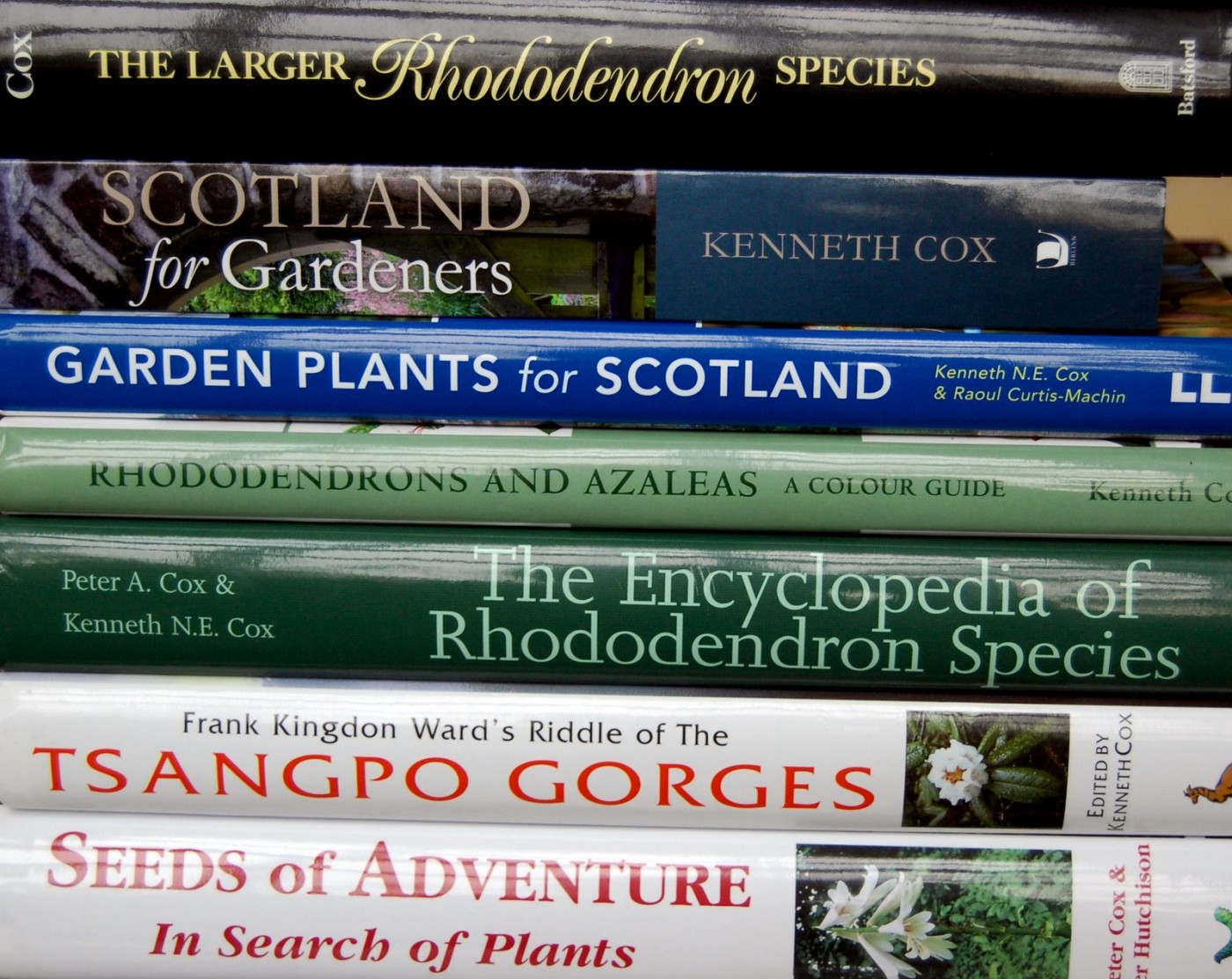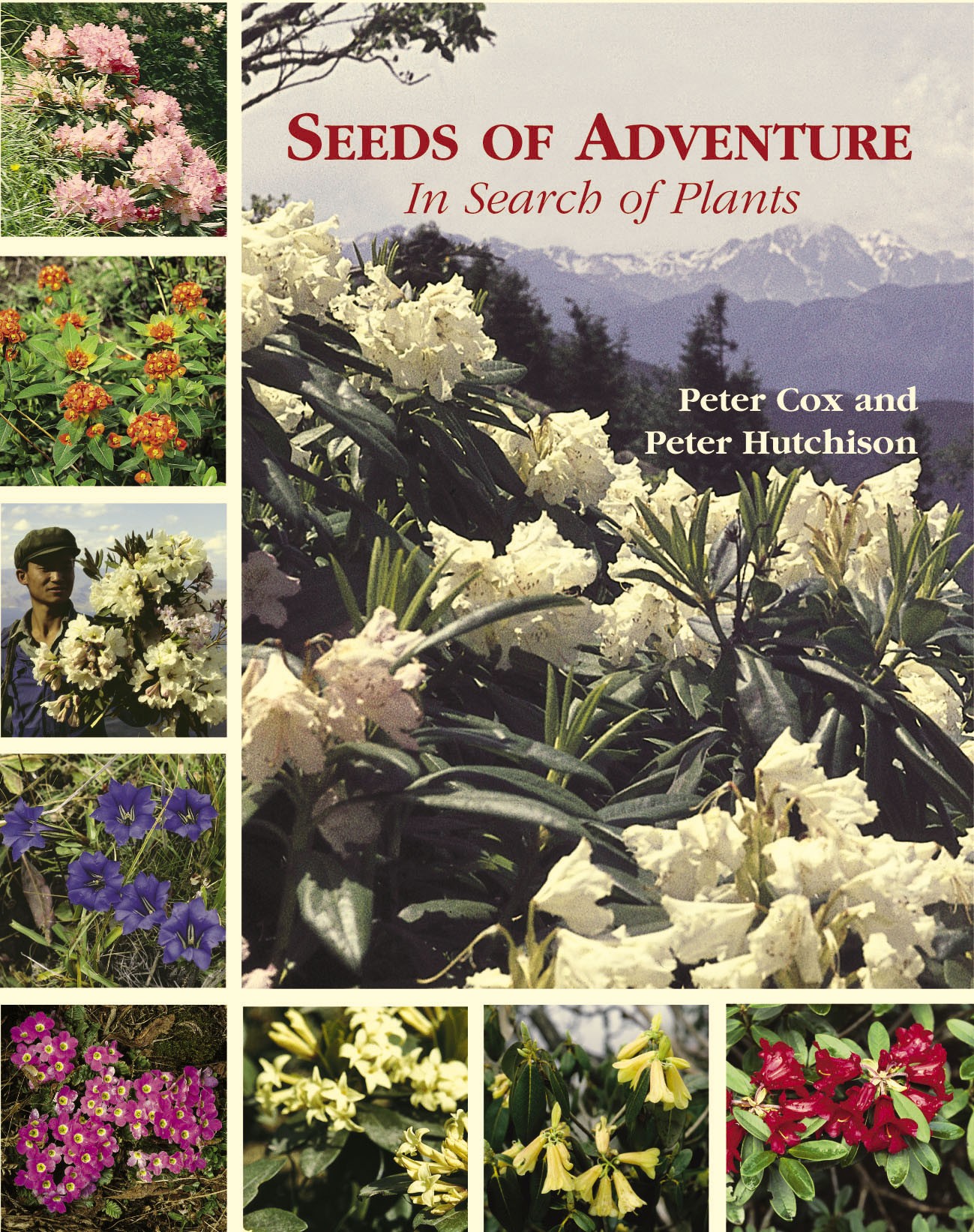

Born 28th February 1934 Died 8th April 2025
Peter Cox was born in February 1934 in Dundee Scotland. His father Euan Cox was a well-known horticultural writer and plant-collector who owned a garden at Glendoick, Perth, Scotland.
Peter Cox writes:
‘My father was very much involved in horticulture in and around London when the bulk of new rhododendrons were coming in from China, Burma and Xizang. He was gardening editor of Country Life, editor of the New Flora & Silva, the writer of various gardening and plant-collecting books, and owner of a bookshop specializing in gardening literature. Thus he kept abreast of all that was new. He frequently visited the great gardens like Tower Court, Exbury and Caerhays where thousands upon thousands of seedlings were being raised from seed just sent back from Asia. He knew all the great collectors of the day: Forrest, Farrer, Wilson, Kingdon Ward, Rock and Ludlow and Sherriff. Being brought up in these circles, I either had to fall completely for the thrills of going on plant-hunting trips myself, or turn against plants and gardening altogether, and I have never regretted going for the former.’
After studying horticulture at college in Edinburgh and working for a year at Notcutts Nurseries, Woodbridge, Peter and Euan founded the rhododendron nursery ‘Glendoick Gardens Ltd’ in 1953. Peter married Tricia Sherrard in 1963. They met when she came to buy rhododendrons for her family garden, Maryborough House, Cork Ireland. Their sons Kenneth (1964) and Raymond (1966) and their parents lived at Sandyhall farm across the fields from Glendoick.
In 1972 Glendoick Garden Centre was opened, largely under the management of Tricia Cox while Peter ran the nursery. Over the years Glendoick became a centre for excellence in all aspects of the culture of, hybridising of and publishing books on rhododendrons.
Peter Cox has probably seen and studied more species of Rhododendron in the wild than any one else at any time. Maybe Steve Hootman has beaten his record now... Peter went on 18 major plant-hunting expeditions and his eye for good garden plants brought back from his travels range from Ulex gallii Mizen from S. Ireland to Rhododendron coxianum which he discovered in India in 1965. He has collected thousands of seed numbers from many parts of the globe, all carefully documented as to altitude, aspects, growing conditions etc. Both the seed itself and many plants grown from it have been distributed to Botanic Gardens and collections in many countries.
Peter Cox writes in The Smaller Rhododendrons
'As a child, I still have a vivid memory of being introduced to Kingdon Ward, by then a tiny, wizened old man with the most wrinkled face I ever saw, and to Rock who once visited the garden here at Glendoick. Ludlow and Sherriff and Mrs Betty Sherriff I had the good fortune to know very well and all three gave me great encouragement to collect in the east myself. I remember Ludlow telling me that while he always wore boots when travelling and collecting, Sherriff always wore gym shoes (plimsolls). Ludlow lived to a much greater age than did Sherriff but I doubt if their different choice in footwear had much bearing on their longevity!'
The mountains of China and most of the Himalaya were no longer accessible to plant hunters from the mid 1950 to the early 1980s due to political upheaval. Plant hunting began with a meeting between Peter Cox and Peter Hutchison in 1960. The two Peters discovered a mutual interest in plant exploration and in 1962 they set out overland in a land rover to Eastern Turkey. Here, amongst other things, they collected the ‘real’ Turkish Rhododendron ponticum (AC&H 205) for perhaps the first time. In 1965, with Patricia Cox, they set off for The Apatani Valley, Arunchal Pradesh, north-east India to an area never before botanically explored, leaving their one-year-old son, Kenneth behind with his godmother Averil. The itinerary was severely curtailed due to political upheaval following the Chinese invasion of Arunachal Pradesh in 1962, but they still managed to discover and introduce several new rhododendron species, including R. santapaui and R. subansiriense.
Peter Cox and Peter Hutchison waited patiently through the 1960s and 1970s for Asian plant hunting opportunities, but it was not until 1981 that it became possible once again to reach the mountains of China. The two Peters were participants in the SBEC expedition to the Cangshan in Yunnan, a joint expedition with Chinese and British botanists and experts, working together for the first time. Isolation from the West meant that the Chinese hosts were not sure what to expect of their western guests and one of the first questions asked by their minders was whether the foreigners would eat rice. The expedition was very successful, and for the first time in almost 30 years, made available large numbers of rhododendrons and other plants, grown from wild seed. Cox and Hutchison, one of the world’s most durable plant hunting partnerships, returned to China, Tibet or the Himalaya almost every year, until they retired to write their memoirs Seeds of Adventure.
Peter Cox Plant-Hunting Expeditions mostly with Sir Peter Hutchison, sometimes with Patricia Cox, Kenneth Cox
1962 N.E. Turkey
1965 Arunachal Pradesh (N.E.F.A.), India. Discovered 3 new species of rhododendron and introduced several other new plants
1981 Sino British Expedition to China- N.E. Yunnan 1981 with Roy Lancaster, etc
1985 Nepal
1986 Yunnan, (Lijiang) Sichuan, China.
1988 Bhutan
1989 China, (Sichuan)
1990 China (Sichuan U.K.-U.S.A. trip)
1992 Sino Scottish Expedition to N.Yunnan (Chungtien, Bei Ma Shan)
1993 Yunnan China, Salween-Mekong divide
1994 Salween Mekong divide (Spring), Yunnan
1995 S.C. Sichuan and N.E. & S.E. Yunnan.
1996 S.E. Tibet, Tsangpo Gorges, Pemako, Namche Barwa (with Kenneth Cox)
1996 S. Chile, with Patricia Cox
1997 Salween, Yunnan, China
1998 Tsari, S.E. Tibet. (With Kenneth Cox)
1999 Sichuan & Guizhou, China
2000 Salween, Yunnan, China
2002 Arunachal Pradesh, (with Kenneth Cox)
2004 Arunachal Pradesh Tawang area, (with Patricia Cox)
· First trip to N.E. Turkey 1962, re-introducing all 5 Rhododendron species to be found there as well as lilies and other plants.
· Exploring new territory in Arunachal Pradesh, N.E. India in 1965 and discovering and introducing 3 new Rhododendron species: R. coxianum, R. santapaui, R. subansiriense.
· First ever joint expedition with Chinese botanists to Cang Shan in Yunnan in 1981. We were permitted to collect plants in addition to seed and introduced or re-introduced many plants such as Anemone trullifolia, Gentiana ternifolia, Paris polyphylla var. thibetica forma alba and re-introduced many rhododendrons such as scarce species R. lacteum, R. taliense, R. cyanocarpum.
· First introductions of Rhododendron dendrocharis to be propagated and put into commerce, 1989.
· Areas visited in 1995 not explored by the great collectors in S.C. Sichuan, N.E. and S.E. Yunnan with several Rhododendron species introduced for the first time:- R. coeloneuron, R. denudatum, R. huianum, R. ochraceum, R. sinofalconeri, R. valentianum var. oblongilobatum.
· Crossing the famous Doshong La in S.E. Tibet in 1996 on one of son Kenneth’s expeditions, one of the few westerners to do this.
· Exploring un-botanised territory in Aruanchal Pradesh in 2002 with Kenneth, and finding new species and ones discovered but not previously introduced. Seeing Rhododendron ludlowii in the wild, the most successful dwarf species used in my hybridisation program.
· Finding Meconopsis grandis aff. which appears to be very close to the famous G.S. 600 (Sherriff collection) in 2004 and seeing it in flower.
The list below includes rhododendrons species discovered or introduced to cultivation from the wild for the first time by Euan, Peter or Kenneth Cox on their expeditions:
R. mallotum, R. santapaui, R. subansiriense, R. coxianum, R. walongense (aff), R. dendrocharis, R. cephalanthum var. platyphyllum, R. ochraceum,, R. platypodum,, R. denudatum, R. coeloneuron, R. molle ssp. molle, R. sinofalconeri Yunnan form, R. huanum , R. miniatum, R. luciferum, R. bulu, R. laudandum, , R. viallii, R. monanthum,, R. trilectorum, , R. kasoense , R. concinnoides, R. cephalanthum Nmaiense group, R. dignabile, R. valentinianum var. oblongilobatum, R. phaeochrysum (yellow form), R. changii, R. pseudocilipes, R. boothii (lost to cultivation in Europe), R. hodgsonii Aff Rudong La, Bhutan, R. populare, and R. titapuriense.
Peter Cox Plant Breeder
One of the most successful and important rhododendron hybridisers ever, Peter Cox saw that the future lay in developing cultivars for the small garden. While most hybridisers concentrated on large, flamboyant plants which would win medals at R.H.S. shows, Peter produced a range of hybrids suitable for everyone to grow. The birds such as ‘Chikor’, ‘Curlew’ and ‘Ptarmigan’ and evegrren azalea 'mammals' such as ‘Squirrel’ 'Panda' and ‘Lemur’ appeared at the rate of around one per year from the mid 1960s and many received awards such as A.M.s , F.C.C.s and A.G.M.s from the Royal Horticultural Society. More importantly, they have become commercial standards in Britain and elsewhere. There can be few garden centres in the U.K. which don’t stock at least one of the Glendoick hybrids. ‘Curlew’, 'Egret', 'Razorbill' and 'Wren' are three of the best known bird hybrids. In the evegreen azalea mammals series ‘Panda’ is a best selling white and 'Squirrel' a succesful red. The hybridising process continues to the present, with a focus on coloured foliage and new colour breaks. compact Hybrids Wine and Roses ['pinkros'] and Evered ['85/1C'] are protected by Plant Breeders rights and have become best sellers.

Peter Cox wrote 13 books (see section below) and wrote 100s of articles for specialist publications, Country Life and many other journals.
Peter Cox created two woodland gardens, the one at Glendoick and another, Baravalla, 3 hours away on the west coast of Scotland which he created with best friend Peter Hutchison. Peter was to be found most days, weeding, watering, planting, pruning and bellowing at errant labradors. He carried on gardening well into his 80s. Son Kenneth is trying to look after all the things he planted...
Peter served for many years on the Gardens Committee of the National Trust for Scotland and on the Board of Trustees of the Dundee Botanic Garden. Peter Cox was a modest and shy man, who had a pronounced stammer and preferred to be gardening at Glendoick or climbing Chinese mountains in search of plants to being the centre of attention. And yet he truly was the world’s ‘Mr Rhododendron’. It is doubtful that anyone has ever known as much or achieved so much in this field and it is doubtful anyone ever will.
Peter & Tricia Cox celebrated their golden wedding in 2013. Peter loved dogs, (black labradors), table tennis, bridge, shooting, wild birds, cricket and talking about plants and plant hunting with fellow enthusiasts. Most of this best friends were plants people.... Roy Lancaster, Steve Hootman, Warren Berg, June Sinclair, Tony Schilling, David Chamberlain and many many more. Peter hated hostas, grasses planted in gardens, bedding plants, had no interest in music, fiction, film, except if it was James Bond or had Nicole Kidman in it. He drank the occasional glass of white wine.. and thought that all other drinks were poison. He was waited on hand and foot by his wife Tricia.. and never knew how lucky he was that she married him. He was a walking, talking plant anorak. He loved rhododendrons. His mother banned talk about them at mealtimes.
Peter Cox died on 8th April 2025. aged 91.
Peter Cox Honours and Awards
The judges commented:
‘Even someone who couldn’t care two hoots about rhododendrons would be gripped by the sheer bloody mindedness of these two as they suffered awkward locals,
ticks the size of pennies, food poisoning, sodden tents and numerous travel headaches in their good-humoured quest.
The anecdotes are delightful, the photographs of plants, people and views are breath-taking. What an inspiration to us all.’
Peter Cox’s favourite and most disliked plants in his own words
'Rhododendrons have always been my chief study and I am proud of the fact that I have studied them from both taxonomic and horticultural angles and from seeds to mature plants, in a large part of where they grow in the wild (except vireyas) and growing in cultivation in many countries of the world. It is the tremendous variety that I find so appealing, plus of course their flowers, scent and foliage.
My other plant interests are mostly those that are associated with rhododendrons in the wild and which can be grown with them in the garden. All have their particular appeals. Meconopsis for their splendid flowers and winter rosettes. Primulas again for their variety, exquisite flowers and challenge to grow well, magnolias for their fine foliage and bold flowers, Sorbus for their showy berries and fine foliage and conifers such as Pinus, Abies and Picea for their handsome foliage and form. I am much attracted by many trees such as eucalyptus and nothofagus, especially after having seen many in the wild.
My chief dislikes are variegated foliage in general, especially scattered yellow spots that look like some horrible virus. I admit though that I do quite like a few variegated trees and shrubs, notably some Cornus and natural variegations on plants like cyclamen, trilliums, erythroniums and some house plants. I also really do not like weird forms like many dwarf conifers, always much preferring plants as they are usually found in the wild. My pet hates start with variegated aucubas which almost make me throw up, followed by variegated hostas and conifers. What could be more inclined to send one to sleep than an hour's talk on variegated hostas? Variegated pachysandra is another miserable plant. '
Peter Cox, Glendoick Biography
BOOKS
Peter Cox’s books are widely recognised as the definitive works on the genus Rhododendron, there is a book to suit every level of interest from the complete beginner to the keenest collector.
Modern Rhododendrons, Nelson 1956. Euan H.M. Cox and Peter A. Cox.
Modern Shrubs, Nelson 1958. Euan H.M. Cox and Peter A. Cox.
Modern Trees, Nelson 1961. Euan H.M. Cox and Peter A. Cox.
The Royal Horticultural Society's Wisley Handbook Rhododendrons, Peter Cox. A beginners guide. (5 editions-first published 1971.)
Dwarf Rhododendrons, Batsford, 1973, Peter A. Cox
The Larger Species of Rhododendron, Batsford, 1979, 1981, Peter A. Cox. Cultivation information and species descriptions.
The Smaller Rhododendrons, Batsford 1985 Peter Cox- cultivation information and species and hybrid descriptions.
The Larger Rhododendron Species Batsford 1990. Updated version of The larger Species.
Encyclopedia of Rhododendron Hybrids- 1988. Peter & Kenneth Cox. 1800 hybrids described + many photographs. A critical guide to choosing from the multitude of hybrids on offer.
Cox’s Guide to Choosing Rhododendrons 1990. Peter & Kenneth Cox. A 'which' guide to making a rhododendron collection. An excellent aid in choosing the best plants for different conditions. Lots of fine photographs.
The Cultivation of Rhododendrons P.A. Cox. Batsford 1993. This well-illustrated book summarises the author's lifetime's experience in cultivating rhododendrons.
The Encyclopedia of Rhododendron Species Glendoick Publishing 1997 Culmination of a lifetime's work. 415 pages, an illustrated guide to all the temperate species of rhododendron illustrated with 1500+ photographs. 5 years in the writing, this is the definitive book on the subject of rhododendron species. 2nd Edition 2000.
Seeds of Adventure Antique Collectors Club 2008 (with Sir Peter Hutchison). Lavishly Illustrated account of 20 plant hunting expeditions. Winner of Garden Media Guild Inspirational Book of the Year 2008

The great plant hunters Ludlow and Sherriff returned to Britain in the 1950s. George Sherriff and his wife started a garden only 50km away from Glendoick and they became great friends of the Coxes.
On an early visit to their home, Ascreavie, Peter spotted a dwarf yellow-flowered rhododendron species with enormous bowl-shaped flowers for the size of the plant which turned out to be a Ludlow and Sherriff introduction Rhododendron ludlowii.
The Sherriffs allowed Peter to take some pollen home which he applied to R. chryseum (now R. rupicola var. chryseum.) In due course, the hybrid R. 'Chikor' was selected and named from this cross and which was given an Award of Merit and later a First Class Certificate by the Royal Horticultural Society.
A chikor is a game bird and this started the theme of naming all dwarf lepidote hybrids after birds, another prime interest of Peter's. From then on, several dwarf crosses were made every year with Kenneth Cox starting to make his own crosses in the early 1980s. There are now almost 25 Glendoick birds which are popular with gardeners and rhododendron collectors in many parts of the world.
BRAMBLING (‘Razorbill' x racemosum) 90cm. H4. New Glendoick hybrid with brightest pink flowers in multiple clusters in April. Fine dark foliage. Very promising.
CHIKOR 30cm. H4. Bright yellow flowers in May. Our first award winning dwarf yellow hybrid. Compact twiggy growth. Needs cool roots & good drainage.
CRANE 75cm. H5. Creamy-white flowers in April. A white version of 'Ginny Gee' which is hardy, very free-flowering and easy to please. One of the best white dwarf hybrids.
CURLEW 40cm. H4 Comparatively large, beautiful, open-faced yellow flowers in April-May. Neat spreading habit and good foliage. Expanding buds need frost protection. A best seller.
EGRET 60cm. H4. Masses of tiny white bells in May. Compact, with shiny, deep green leaves. One of our most popular introductions, quite unlike any other hybrid. Recommended.
EIDER 60cm. H5. Pure white long-lasting flowers in April. Flowers relatively frost resistant. Foliage yellowish-green.
EUAN COX 15cm. H4. Tight glossy foliage and fine yellow flowers on every shoot in late May. A real winner, easier to grow than either parent. The one hybrid made by nursery founder Euan Cox.
GLENDOICK FLAMINGO 20cm H4-5 NEW brightest pink. very compact.
GUILLIMOT 50cm (NEW 2016) Lightly scented white fls from orange-brown buds in march indoors, April outdoors. Dark foliage. Opens buds over several; week. (levinei aff x moupinense Fulmar)
MERGANSER 45cm. H4. Freely produced yellow bells in May. Very neat habit with dark green foliage.
PINTAIL 60cm. H4. Masses of spectacular brightest pink flowers in multiple trusses in April. A compact plant with good foliage.
PIPIT 20cm. H3-4. Charming flat-faced pink flowers with darker markings in late May. A natural hybrid from Nepal. Needs extra care.
PLOVER 50cm H4 M The first scented pink dwarf hybrid hardy outdoors at Glendoick. Deep green leaves. Needs good drainage.
PTARMIGAN 30cm. H4. The 'Snow Grouse' is covered every year by a carpet of pure white flowers in March-April. Flowers open over a long period during spells of mild weather, so it nearly always puts on a show. Creeping/spreading habit.
QUAIL 30cm. H4. Bright red buds open to deep reddish-pink in April-May. Compact habit. Very free-flowering, the flowers last best in part-day shade. Almost a true red lepidote dwarf.
RAZORBILL 60cm. H4. A remarkable introduction with brightest pink long-lasting flowers late April-May, in tight upright trusses. Attractive crinkled leaves on a sturdy plant.
SWIFT 60cm, H3-4. Fine yellow flowers, strongly spotted red, very freely produced in May. Not for gardens colder than Glendoick. Like ‘Curlew' but a bit later flowering and more bud hardy.
TANAGER 75cm H4 L Pale yellow bells in late May- early June. Vigorous. Latest flowering of the birds.
TINKERBIRD 75cm. H3-4. ` Masses of scented cream-white flowers in early May. A real breakthrough: a compact, scented dwarf which grows outdoors at Glendoick. Best in a sheltered site. Surprisingly bud hardy. Also good as a pot plant.
TREE CREEPER (keiskei x glaucophyllum C) 30cm. H4. Pink buds opening to flower pink on outside cream inside, giving an attractive two-toned effect. Compact habit. Very free-flowering. Flowers last best in part day shade.
WIGEON 60cm. H5. A Glendoick introduction. Fine slightly glaucous foliage, compact habit and saucer-shaped pink flowers, spotted deeper, in May.
WREN 20cm. H4. Smothers itself with clear yellow flowers in May. A gem, popular with rock garden enthusiasts, which forms a tight mat of attractive, shiny leaves.
Arctic Fox (‘Panda x Mucronatum’) Large pure white flowers. Pale leaves.
Chipmunk (‘Chippewa’ x ‘Vida Brown’) Hose in hose bright pink flowers, very compact.
Glendoick ®™ Crimson (‘Squirrel’ x ‘Red Red’) Dark red flowers in May.
Glendoick ®™ Dream (‘Panda’ x ‘Rokoko’) Double, ruffled purplish red flowers in May.
Glendoick ®™ Ermine (‘Panda x Mucronatum’) Large pure white flowers.
Glendoick ®™ Garnet (‘Squirrel’ x ‘Red Red’) ‘Hot’ deep red flowers May.
Glendoick ®™ Glacier (‘Panda’ x ‘Rokoko’) Double white flowers.
Glendoick ®™ Goblin (‘Squirrel’ x ‘Red Red’) Hot red flowers, petalloid stamens.
Glendoick ®™ Snowflake (Arctic Fox x Diamant White) Pure white, compact.
Lemur (‘nakaharae x ‘Vuyk’s Scarlet’) Deep pink flowers, low growing.
Panda ‘Everest x kiusianum White’ White flowers. Our best seller.
Opossum ( Blue Danube x Purpurtraum) dark purple, spreading
Racoon (nakaharae x) Bright red flowers in June-July, compact, spreading.
Squirrel (nakaharae x ‘Galathea’) Bright scarlet flowers in June.
Wombat (nakaharae ‘Mariko’ x ‘Gaiety’) Pink flowers, spreading ground cover.